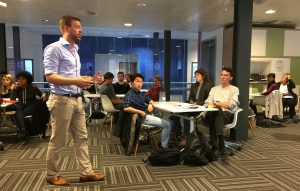Activating students during lectures can be challenging, but is rewarding. It helps to capture and maintain students’ attention and engagement in order to foster deeper learning.
Before you start
Make sure that the activating teaching (activity) is not just entertainment or a mere alternative to listening, but conducive to students’ learning. This comprises designing activities that help students achieve the learning objectives of the course.
Getting started
A basic activating teaching strategy that requires little preparation is asking questions during the lecture. Depending on your goals, different types of questions can be useful:
- Recollection (& application): which of the four treatment that we’ve discussed is most useful (for X)?
- Prediction / thinking along: what do you think are the main causes of Y? How would you design a study to explore Z?
- Argumentative/evaluative: do you agree with assertion C and why? What would be a counterargument to what I’ve just explained?
- Analysis: how does A compare to B? In what ways are the findings of study A and B inconsistent/contradictory?
Answering is often voluntary, likely resulting in an interesting discussion with a particular (type of) student, but to activate all students you could consider:
- Having students discuss answers with their neighbours
- Having students raise hands or stand/sit to indicate their response
- Randomly asking students to answer
- Using an electronic voting system
Knowing that their answers matter is crucial for students’ motivation for and engagement in class and for the activation to be effective for learning, therefore make sure to refer to their answers.
Activating students during lectures can be time consuming. It can save time to ask students to complete some of the activities outside of class (e.g. make a mind map on topic X, formulate arguments for a debate, reflect on a question, make a summary) and possibly submit it online.
-
- If students submit their preparation work online before class, you can adapt your lecture accordingly.
- If students submit their “answers” to the activity related to the lecture after class, it will help you to assess how effective your lecture was.
More challenging ways of activating students during lectures are described below.
Resources
- https://www.staff.universiteitleiden.nl/education/it-and-education/tools-and-teaching-methods/activating-learning/humanities?cf=interfaculty-institutes&cd=leiden-university-graduate-school-of-teaching – Describes ICT tools and teachers’ experiences with them to support activating students.
- https://www.kcl.ac.uk/study/learningteaching/Learning-and-Teaching-Support/QuickGuides/kcl-qg/dl/7ways-engage-students-lectures.pdf – Handout with 7 tips to activate students during lectures, including using incomplete handouts and using demonstrations or examples.
- https://www.kuleuven.be/onderwijs/werkvormen/activeren_studenten/activeren_college
- https://www.kuleuven.be/english/education/teaching-tips/activating-students/giving-an-activating-lecture – Webpage links to several online resources to illustrate how you can design an interactive lecture and lists tools for having students think along and act during a lecture and even take over the lecture.
- http://mararchief.tudelft.nl/file/2763/ – PhD thesis by Liesbeth van Dijk on possibilities and effects of activating during lectures at the Technical University of Delft. Results show that asking questions, peer-instruction, making interactive assignments, giving assignments and voting are effective ways of activating students during lectures (in Dutch, with summary in English).

